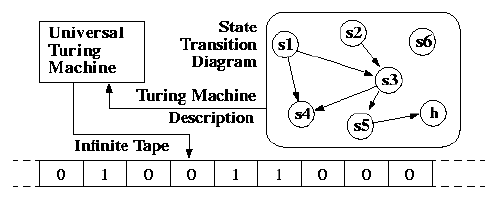Alan Turing (1912-1954) was one of the most influential scientists and mathematicians of the 20th century. Although less well-known during his lifetime, his pioneering work in the fields of mathematics, cryptography, computer science, and artificial intelligence formed the basis for modern computing technology. This Science Shot provides an overview of Turing’s key contributions across these scientific domains.

Foundations of Computer Science
Turing is today considered one of the founders of theoretical computer science and artificial intelligence. In 1936, at age 24, he published his seminal paper “On Computable Numbers” (Turing, 1936) where he conceptualized an abstract machine known today as a Turing machine. This was an attempt to rigorously define the notion of a “computable function” - something that can be calculated via an algorithm.

Turing described an infinitely long tape which acts as the machine’s data storage, with the machine able to read and write symbols anywhere along the tape. The machine transitions between different internal “states” based on the symbol it reads on the tape, following a fixed set of rules. This links the current state and symbol to an action (writing a new symbol), a tape motion (left or right), and transition to a new state. By carefully defining a set of rules, the Turing machine can thus calculate any computable function, forming the basis for the modern theory of algorithms and computation.
This conceptual “Turing machine” model allowed the formal definition of a universal computing machine that could be programmed to simulate any other Turing machine. The Church-Turing thesis, developed in conjunction with Alonzo Church’s lambda calculus model, states that anything that is effectively calculable is computable by a Turing machine. This still forms the practical basis for our understanding of what problems can be solved algorithmically by a mechanical computer.
Cryptanalysis of the Enigma
During World War II, Turing was a pioneer in breaking German ciphers at Bletchley Park in England. Most importantly, he made major advances in deciphering messages encrypted by the German’s “Enigma” cipher machine.
Previous Polish breakthroughs had determined the logical structure of the Enigma, but the Germans increased its complexity by changing the cipher settings each day. Turing invented a number of techniques for “cracking” these settings, including the development of a statistical method called “Banburismus” which allowed likely Enigma settings to be derived from analyzing cipher-text.
Together with Gordon Welchman’s improvements to build the “Bombe” electromechanical machine, Turing’s methods allowed the near complete decryption of strategic Enigma-encrypted communications. Winston Churchill would later describe this as the single biggest contribution to Allied victory over the Nazis in WWII (Hodges, 2012). The analytical and computational techniques Turing pioneered also laid the foundations for all future signals intelligence.
Artificial Intelligence & the Turing Test
In addition to practical cryptography, Turing was fascinated throughout his career by the question of whether machines could think. In 1950, he published a paper entitled “Computing Machinery and Intelligence” (Turing, 1950) which addressed the philosophical debate about artificial intelligence.
In this paper, he proposed an empirical approach to evaluating whether machines can demonstrate intelligent behavior equivalent to human cognition. This lays out the core conceptual framework of the now famous “Turing Test”. The test involves a human judge conversing with both a machine and another human via text interface, then evaluating if the machine exhibits behavior indistinguishable from human intelligence.
This though experiment circumvents theoretical debates about consciousness to focus evaluation on externally observable intelligent behavior. In the decades since it was first proposed, the Turing Test has become the de facto benchmark for evaluating artificial intelligence, despite disagreements about its utility amongst researchers in the field. Regardless, it highlights Turing’s contribution in shifting AI towards a practical, evidence-based scientific discipline concerned principally with behavior rather than abstract debates about qualia.
Impact on Computer Hardware Development
Turing’s post-war research centered on early efforts to actually build computing machinery for practical use. In 1945, he joined the National Physical Laboratory to lead development of one of the first designs for a stored-program digital computer (Hodges, 2012). Though this early work faced practical hurdles, he continued to refine his ideas about computer architecture and programming.
In his “Lecture to the London Mathematical Society” in 1947, he outlined key hardware requirements for a general-purpose programmable computer, including high-speed memory, input/output systems, and central processors able to execute logical and arithmetic operations (Turing, 1947). These architectural recommendations were enormously influential on early computer engineers in the UK and formed a basic blueprint for modern computer hardware systems.
Turing also made major contributions to early work on computer programming and software. He wrote some of the first code and programs meant to actually operate on computer hardware under development. In 1947, he also published a paper on “Checking a Large Routine” (Turing, 1947b) which outlined conceptual ideas about programming errors, debugging, and automatic verification that prefigured innovations still critical in modern software engineering.
Conclusion
Though Turing’s life ended tragically early at age 41, his scientific and engineering breakthroughs across mathematics, cryptanalysis, computer science, and artificial intelligence formed the conceptual foundation for the modern information age.
His insights on computational logic and what machines could in principle compute revolutionized our technological capability to process information. And his practical contributions to cracking encrypted communications proved pivotal in the Allied victory in World War II. Turing’s legacy lives on whenever we use computers today for computation, encryption, or attempts to model intelligence itself.
References
- Hodges, A. (2012). Alan Turing: The Enigma. Princeton University Press.
- Turing, A. M. (1936). On computable numbers, with an application to the Entscheidungsproblem. J. of Math, 58(345-363), 5.
- Turing, A. M. (1947). Lecture to the London Mathematical Society on 20 February 1947. The Charles Babbage Institute Reprint Series for the History of Computing, 10.
- Turing, A. M. (1947b). Checking a large routine. The early British computer conferences, 70-72.
- Turing, A. M. (1950). Computing machinery and intelligence. Mind, 59(236), 433-460.